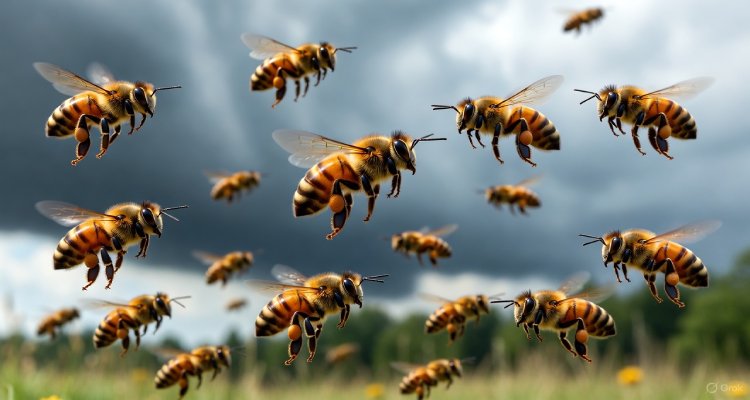The Insects That Control the Weather
Can insects really control the weather? Scientific studies reveal how insect behavior and atmospheric shifts are interconnected, influencing climate patterns in surprising ways.
Introduction: The Sky’s Secret Architects
On a humid summer afternoon, the sudden silence of crickets and a frantic retreat of bees often precedes rolling thunderclouds and rainfall. Is it just coincidence, or do insects somehow sense—and perhaps influence—the weather? Recent research and field observations suggest that these tiny creatures not only respond to meteorological changes but might be subtly helping to shape them, making them unsung influencers in the dynamic dance of climate.
Context & Background: Nature’s Sensitive Barometers
Throughout history, farmers and naturalists have relied on insect behavior as a barometer for weather prediction. The folklore of dragonflies swooping before rain or ants building higher mounds in anticipation of storms persists worldwide. Far from superstition, modern studies confirm that many insects possess remarkable abilities to detect environmental cues such as barometric pressure, humidity, and even changes in electromagnetic fields, adapting their actions in response to looming changes in weather conditions.reddit
This adaptation is no accident. Insects—from bees and butterflies to beetles and moths—are directly affected by weather shifts, which influence their migration, mating, and survival. The impact is reciprocal: their physiological responses can ripple outward, subtly interacting with atmospheric dynamics.pnas
Main Developments: Weather Warriors in Action
Scientists have uncovered how insects’ responses to shifting weather go far deeper than simple shelter-seeking. For instance, many bees and butterflies can sense drops in barometric pressure, a harbinger of storms, and adjust their foraging and mating patterns accordingly. Such behavioral shifts aren’t just for survival—they also affect pollination timing, food webs, and even the spread of plant species across landscapes.nature+1
But the potential weather-modulation role of insects goes further. Swarms of insects—such as locusts or massive butterfly migrations—have been captured on weather radar, sometimes thick enough to affect cloud formation. Some research suggests these clouds of insects can scatter sunlight, modify local humidity, or even act as condensation nuclei for rain. Even mosquitoes, famed for their rain-defying flight, showcase adaptations that mesh biological needs with weather patterns, demonstrating resilience against downpours by virtue of their small size and specialized wings.greenpestservices+1
Expert Insight & Public Reaction
Entomologists and climate scientists increasingly recognize that insect populations are both indicators and participants in changing climates. Dr. Caitlin Halsch, a researcher specializing in insect climate interactions, notes, “Insects have evolved alongside weather for millions of years. Their responses can shape local ecosystems—and, at scale, may feedback into the atmospheric system itself”.pnas
Public awareness, meanwhile, is growing. Farmers monitor insect activity for hints of impending rain, while urban dwellers are reminded of nature’s sensitivity during seasonal booms or busts in insect populations. Environmentalists warn that declines in pollinator species, exacerbated by global warming, may disrupt these ancient weather-sensing mechanisms, threatening both agriculture and biodiversity.
Impact & Implications: When Bugs Move the Climate
So what happens next? With rising temperatures, unpredictable rainfalls, and more frequent weather extremes, insects are being pushed to their adaptive limits. Some thrive—like moths and aphids that become more abundant after warm winters—while others struggle, especially in more sensitive tropical or mountain environments. Shifts in insect activity can cause cascading effects on crop pollination, pest outbreaks, and even wildflower blooms, all of which cycle back to influence atmospheric conditions and the stability of local climates.greenpestservices+1
This relationship isn’t one-way: As human-driven climate change accelerates, insect-mediated weather effects and the services they provide could be diminished or destabilized. Conservation efforts focused on preserving diverse insect populations may be essential, not just for ecological reasons but for the subtle reins these creatures hold over the weather we experience daily.
Conclusion: The Hidden Weather Weavers
When the sky darkens and leaves rustle before a summer storm, it’s worth pondering the invisible web connecting insects and the atmosphere. Far from passive victims of weather, insects are active participants—detecting, responding, and, in some cases, nudging weather patterns in ways scientists are only beginning to map. In their delicate wings and instinctive routines, the secrets of adaptation, survival, and perhaps even subtle climate engineering reside. As climate change challenges old certainties, understanding the full impact of “the insects that control the weather” may prove vital for our forecasts—and our future.
Disclaimer : This article is for informational purposes only and does not constitute scientific or meteorological advice. For specialized guidance, consult qualified entomologists or climate experts.










